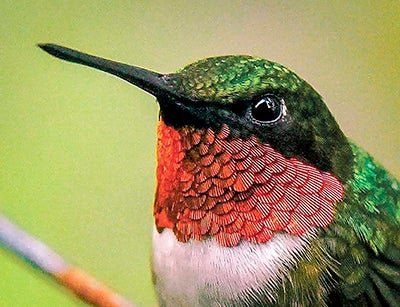Nature Notes: Humming birds are jewels of the sky
Published 6:30 am Wednesday, August 5, 2020
|
Getting your Trinity Audio player ready...
|
By Alison Jennins
Lovingly referred to as ‘jewels of the sky,’ most people have a fascination with hummingbirds. They come in many colors with names like Sapphire-bellied, Honduran Emerald, Blue-throated Mountain-gem, and Ruby-throated.

Jewels of the sky — hummingbirds. Photo provided
As the only regular hummingbird found east of the Mississippi River, most of us are familiar with the ruby-throated. The striking red and green coloration make the ruby-throated hummingbird a beautiful sight to behold. The red feathers appear on the throat or the “gorget” of the male Ruby-throated hummingbird. As with many species of birds, the males are more colorful than the females. If you manage to get close enough, you may notice that female ruby-throated hummingbirds have a single red feather on their gorget. Male hummingbirds use their bright red gorgets to attract potential mates. These beautiful birds are Minnesota’s smallest bird and only hummingbird migrant.
Hummingbirds get their name from the humming sound they make when they fly. These little birds move at an impressive speed, moving their wings at about 60-70 beats per second. It is said that they can fly at speeds of up to 35 mph! They move so fast that many people only ever catch a glimpse of them. Since hummingbirds fly in a similar pattern to insects, they are sometimes confused for larger insects and moths. Many moth species in the genus Hemaris, are called Hummingbird moths because they are often seen flitting around from flower to flower in search of nectar.
Ruby-throated hummingbirds are migratory visitors to Minnesota. Spending the winter in Mexico and Central America, they migrate to Minnesota in early Summer for their breeding season. By mid-August, ruby throated Hummingbirds are starting to prepare for their journey South. There are biological and environmental triggers that spur hummingbird migration. Changes in sunlight and food availability signal that it is time to migrate. Before migration, hummingbirds will molt their old feathers and pack on extra weight to prepare for the long and tiring journey to their winter grounds. A hummingbird will double its body weight in order to complete the 3,000-mile trip from Minnesota to Mexico.
In the summer, many people enjoy putting out feeders to watch these little birds in action. Those with flowering pollinator gardens will also attract hummingbirds. Native plants with tubed, funneled, or cup shaped flowers, are especially attractive to hummingbirds. Popular choices are Bergamot, Cardinal Flower, Phlox and Columbine. Hummingbirds are attracted to the color red, so red feeders and flowers are a good choice. Even though nectar makes up a large part of their diet, hummingbirds also need protein. They get this additional protein by eating smaller insects. Hummingbirds are not only fun to watch, but they are essential pollinators. It is said that 75 percent of the world’s flowers rely on insects, birds and bats for pollination. Hummingbirds pollinate flowers in our parks and gardens, adding a splash of color to our lives.
August at the Nature Center
Classes being offered
Wednesday: 9:30 – 11:30 a.m., Junior Naturalists ages 8 – 9 years – Session 1; 1:30 – 3:30 p.m., Junior Naturalists ages 8 – 9 years – Session 2
Thursday: 9:30 – 11:30 a.m., Junior Naturalists ages 8 – 9 years – Session 1 ; 10 – 11 a.m., Water Wonders: Streams to Oceans ages 2 – 4 years; 1:30 – 3:30 p.m., Junior Naturalists ages 8 – 9 years – Session 2; 6 – 7 p.m., Pristine Prairies: Jay C. Hormel Nature Center and Serengeti ages 5 – 6 years
Friday: 10 – 11 a.m., Water Wonders: Streams to Oceans ages 2 – 4 years; 6 – 7 p.m., Pristine Prairies: Jay C. Hormel Nature Center and Serengeti ages 5 – 6 years
Aug. 18: 9 – 11:30 a.m., Cedar River Canoe Trip ages 12 – 14 years
Aug. 25: 1:30 – 3:30 p.m. Monarch Tagging ages 10 – 12 years
Aug. 26: 3:30 – 5 p.m.,Volunteer Work Party: Seed Collection; 4 – 6 p.m., Family Monarch Tagging
Aug. 28: 8 a.m. to 4 p.m., Red Cross Blood Drive – Ruby Rupner Auditorium


